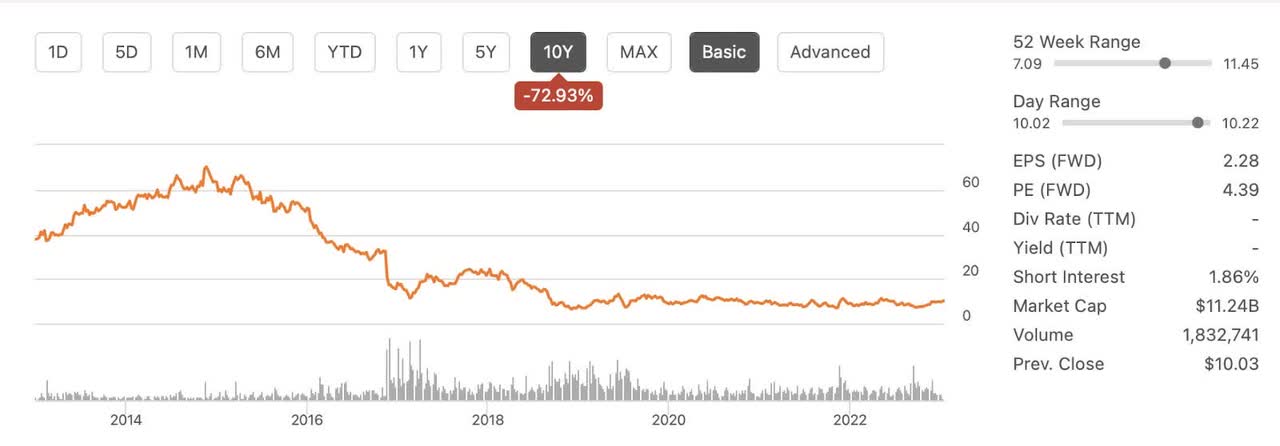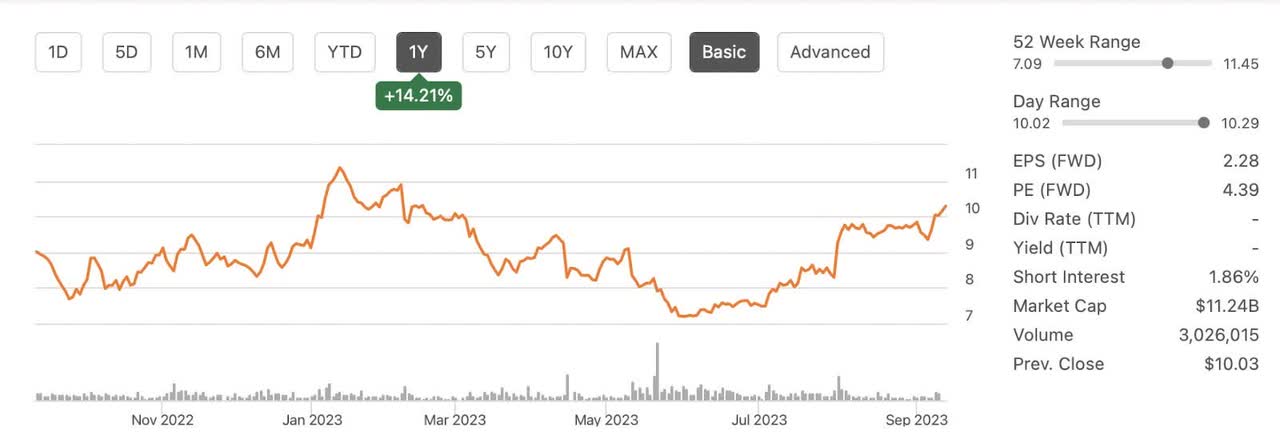Summary:
- Teva Pharmaceutical Industries has faced significant challenges and a decline in shareholder value over the past decade.
- The company has resolved its opioid litigation with U.S. states and is focusing on maximizing growth in innovative products and becoming a generics powerhouse.
- Teva’s strategic shift and efficient capital allocation position it for potential recovery and success, although it still faces risks and must execute its strategy effectively.
- Focus on growth and innovation should drive future profits.
gangliu10/iStock via Getty Images
One of the first stocks I ever looked at was Teva Pharmaceutical Industries (NYSE:TEVA). It had a drip option at Computershare (OTCPK:CMSQY) when I first started investing over twenty years ago. At the time, I decided to pass on the stock because I did not believe it had the necessary risk reward profile that I like. TEVA has had a tumultuous last ten years as the world’s largest generic drugmaker but to misquote one of my favorite Bob Dylan songs, “The Times at Teva Are A-Changin”. The lyrics to Dylan’s song are oddly appropriate in the case of TEVA.
The Past Problems
Teva could definitely be labeled as a loser for shareholders over the last decade but savvy investors know that former losers can become winners again.
Critics have been critical of Teva over the years and for good reason. Teva was one of many drug companies at the heart of Opioid litigation, and while Purdue, Mallinckrodt (OTC:MNKTQ) and Endo (OTC:ENDPQ) each reached settlements of their opioid claims in bankruptcy, Teva is still standing.
In June 2023, Teva announced that, “Teva has resolved its opioid litigation with all 50 U.S. states and more than 99% of the litigating subdivisions and special districts. The company anticipates making its first payment under the nationwide opioids settlement agreement in the second half of 2023. Teva has already begun shipments of its generic version of the life-saving medication, Narcan®(naloxone hydrochloride nasal spray) under its prior opioid settlements, and it expects to expand these shipments under the nationwide opioids settlement agreement in 2024.” This major liability overhang is one of the main reasons that Teva has lost 72% of its value over the last decade.
The total costs of all opioid settlements will be over $4.5 billion including the $4.25 billion settlement with 48 states that you can read about here.
Teva has also had to settle recent price fixing litigation with the Department of Justice which cost them $225 million which you can read about here.
The bad news seemingly never ends, but I would argue that perhaps now the times are changing. Most of these settlements will be paid off over time and some of them will be paid for with products like Narcan. These settlements have paved the way for the company to focus on profits and shareholders once again.
Background
Founded in 1901, the company’s headquarters are located in Tel Aviv, Israel. Teva is a large company with many products and services including but not limited to those mentioned below.
Teva Pharmaceutical Industries is a pharmaceutical company that engages in the development, production, marketing, and global distribution of a wide range of medical products. These include generic medicines, specialty drugs, and biopharmaceuticals, serving markets in North America, Europe, Israel, and across the world. The company’s product offerings encompass sterile items, hormones, high-potency medications, and cytotoxic substances, delivered in various forms such as tablets, capsules, injectables, inhalants, liquids, transdermal patches, ointments, and creams.
Teva also plays a role in manufacturing and selling active pharmaceutical ingredients and extends contract manufacturing services. Furthermore, the company operates an out-licensing platform, offering a diverse product portfolio to other pharmaceutical entities. Teva Pharmaceutical Industries has a strong focus on therapeutic areas such as the central nervous system (CNS), pain management, respiratory health, and oncology.
In the CNS segment, the company’s notable products include Copaxone for treating relapsing forms of multiple sclerosis, AJOVY for preventing migraines in adults, and AUSTEDO for addressing neurodegenerative and movement disorders associated with conditions like Huntington’s disease and tardive dyskinesia. In the respiratory therapeutic field, Teva provides solutions for asthma and chronic obstructive pulmonary disease, including ProAir RespiClick, QVAR, and others. Additionally, their oncology portfolio comprises drugs like Bendeka, Treanda, Granix, Trisenox, Lonquex, and Tevagrastim/Ratiograstim.
Teva Pharmaceutical Industries has entered into a collaboration with MedinCell to jointly develop and commercialize long-acting injectable products, particularly a risperidone suspension designed for treating patients with schizophrenia.
Generics
The overall scope of Teva’s business is quite impressive. Teva provides many life saving generic medicines at low prices across the world. The relatively low margins of the generic drug business has limited Teva’s profitability despite its scale. Teva is aware of this problem and has begun working on a four pillar strategy focused on generics, biosimilars, innovation and growth.
The Future Opportunity
During Morgan Stanley’s 21st Annual Global Healthcare Conference, Teva’s CEO Richard Francis addressed their pivot towards growth by talking about the four pillars:
-
“One of those is to maximize our growth engines around our innovative AUSTEDO, UZEDY and AJOVY, we can talk about those.”
-
“The second was to step up innovation. We have a pipeline that I think is maybe a bit of a surprise to people from some of the products we have. Obviously, the best is one known as the TL1A, but we have some really exciting assets other than that, so to make sure we drive that innovation through to the market.”
-
“The third pillar was to make sure we create a generics powerhouse and make sure our generics business performs consistently over time, generating growth on the top-line and the bottom-line.”
-
“And the final thing was to focus the business to make sure all the capital is allocated to the right growth engines, which drive the top-line and the bottom-line. And within that was the announcement that we were going to move TAPI, our API business, to a standalone business to allow that to benefit from what is a very exciting API market.”
Teva’s shift to focus on capital allocation stands out as a key element of its strategy, with a clear emphasis on prioritizing innovation. This underscores the company’s recognition that investing in research and development is pivotal, as it drives both top and bottom-line growth. This commitment aligns with the company’s intention to become a generics powerhouse, a goal characterized by consistent growth in revenues and profitability.
To achieve this objective, Teva aims to optimize its generics pipeline by narrowing its focus on a select number of patented products coming off-patent, reducing complexity, and speeding up time-to-market. The implication here is that Teva intends to achieve more with fewer resources, leading to cost savings and a more efficient allocation of capital. Moreover, Teva plans to declutter its manufacturing portfolio by removing unprofitable or highly dilutive products, streamlining operations, and further reducing costs. This approach is indicative of the company’s commitment to maintaining a leaner, more agile manufacturing operation, ultimately contributing to its bottom line.
The overall message is that Teva is taking a measured and strategic approach to allocate its capital efficiently. This approach not only underscores its commitment to innovation but also highlights its drive to eliminate inefficiencies in its manufacturing processes. Teva’s emphasis on reallocating resources as needed underscores its flexibility and adaptability in responding to market dynamics and emerging opportunities.
Looking ahead, this capital allocation strategy positions Teva to make prudent investments in areas such as biosimilars and generics while maintaining cost-consciousness. By reallocating resources effectively and maintaining a firm grip on its cost base, Teva aims to position itself for sustainable growth in the pharmaceutical industry. However, the company’s success will ultimately depend on its ability to execute this strategy effectively and navigate the competitive pharmaceutical landscape while delivering on its promises of innovation and efficiency.
These steps would indicate that Teva acknowledges that it must address its past mistakes and change in order to adapt to future challenges. It seems that the times at Teva are indeed changing.
Risks
Regulatory Challenges: Teva operates in a highly regulated industry. Changes in pharmaceutical regulations, pricing, and intellectual property laws can significantly impact the company’s ability to market and sell its products, especially generics. Regulatory hurdles can lead to delays, increased costs, and market exclusivity for competitors.
Patent Expirations: Teva’s focus on generics means it often relies on the expiration of patents for branded drugs. The timing and success of generic product launches depend on the expiration of these patents, and any delays or legal challenges can affect revenue projections.
Competition: The generics market is intensely competitive, with numerous players vying for market share. Increased competition can lead to pricing pressures, reducing profit margins. Teva must continually innovate and optimize its product portfolio to maintain a competitive edge.
Lawsuits and Litigation: Teva faces the risk of patent infringement lawsuits from branded pharmaceutical companies, which can result in substantial legal costs, fines, or injunctions against product sales.
Pricing Pressures: Healthcare cost-containment efforts and government policies can lead to pricing pressures in the pharmaceutical industry. Teva’s profitability can be impacted by reimbursement cuts, price erosion, and healthcare reforms.
Pipeline Risks: The success of Teva’s strategy relies on its ability to develop and bring generics to market efficiently. Delays in the development pipeline, regulatory approvals, or supply chain disruptions can affect revenue projections and profitability.
Intellectual Property Risks: Teva’s portfolio of generic products depends on its ability to navigate the complex landscape of patents and intellectual property rights. Challenges in identifying non-infringing pathways to market can lead to legal disputes and delayed market entry.
Supply Chain Vulnerabilities: Disruptions in the pharmaceutical supply chain, such as shortages of raw materials or disruptions in manufacturing, can impact Teva’s ability to produce and deliver products on time.
Market Access and Reimbursement: Market access and reimbursement for pharmaceutical products can be influenced by government policies, health insurance providers, and formulary decisions. Changes in these factors can affect the demand and pricing of Teva’s products.
Final Thoughts
Teva Pharmaceutical Industries has faced a tumultuous past decade, with challenges ranging from opioid litigation to price-fixing settlements, leading to a significant decline in shareholder value. However, as Bob Dylan’s lyrics aptly suggest, “The Times at Teva Are A-Changin’.” Recent developments, including the resolution of opioid litigation with U.S. states and a shift in focus toward innovation and growth, signify a potential turning point for the company.
While Teva has settled many of its legal liabilities, the financial burdens of these settlements, which collectively exceed $4.5 billion, remain a substantial concern. The company’s ability to manage these liabilities and allocate resources effectively will be instrumental in its recovery and future success.
Teva’s strategic shift involves maximizing growth engines in innovative products like AUSTEDO, UZEDY, and AJOVY, as well as driving innovation across its pipeline. Additionally, the commitment to creating a generics powerhouse highlights the company’s determination to achieve consistent growth in both top-line and bottom-line figures.
Efficient capital allocation, particularly in the generics segment, aims to streamline operations, reduce complexity, and deliver more value with fewer resources. This strategy positions Teva to navigate the competitive pharmaceutical landscape effectively while prioritizing innovation and cost-consciousness.
Despite these positive steps, Teva faces risks such as ongoing legal and regulatory challenges, intense competition in the generics market, and the need to successfully execute its strategic pivot. The company’s ability to adapt to changing times, address past issues, and capitalize on growth opportunities will be critical to its future prospects. As Teva continues to evolve, it remains a company to watch closely, given the potential for significant transformations in the pharmaceutical industry.
I believe Teva has taken the steps necessary to turn the company around creating a possible inflection point that should reward current shareholders. I rate Teva a current strong buy and believe that the turnaround has already started. I would be interested in accumulating long term shares at prices from $8 to $11 but I would prefer to buy shares at or under $9. For full disclosure, I established my position in May for under $8 and think this was an optimal entry. However, I do not know if it will get back to this level so I am considering adding on the way up. As always, please do your own due diligence prior to investing in any stock and good luck investing. If you like the article, please like, share and subscribe. Thanks for reading.
Analyst’s Disclosure: I/we have a beneficial long position in the shares of TEVA either through stock ownership, options, or other derivatives. I wrote this article myself, and it expresses my own opinions. I am not receiving compensation for it (other than from Seeking Alpha). I have no business relationship with any company whose stock is mentioned in this article.
Seeking Alpha’s Disclosure: Past performance is no guarantee of future results. No recommendation or advice is being given as to whether any investment is suitable for a particular investor. Any views or opinions expressed above may not reflect those of Seeking Alpha as a whole. Seeking Alpha is not a licensed securities dealer, broker or US investment adviser or investment bank. Our analysts are third party authors that include both professional investors and individual investors who may not be licensed or certified by any institute or regulatory body.



